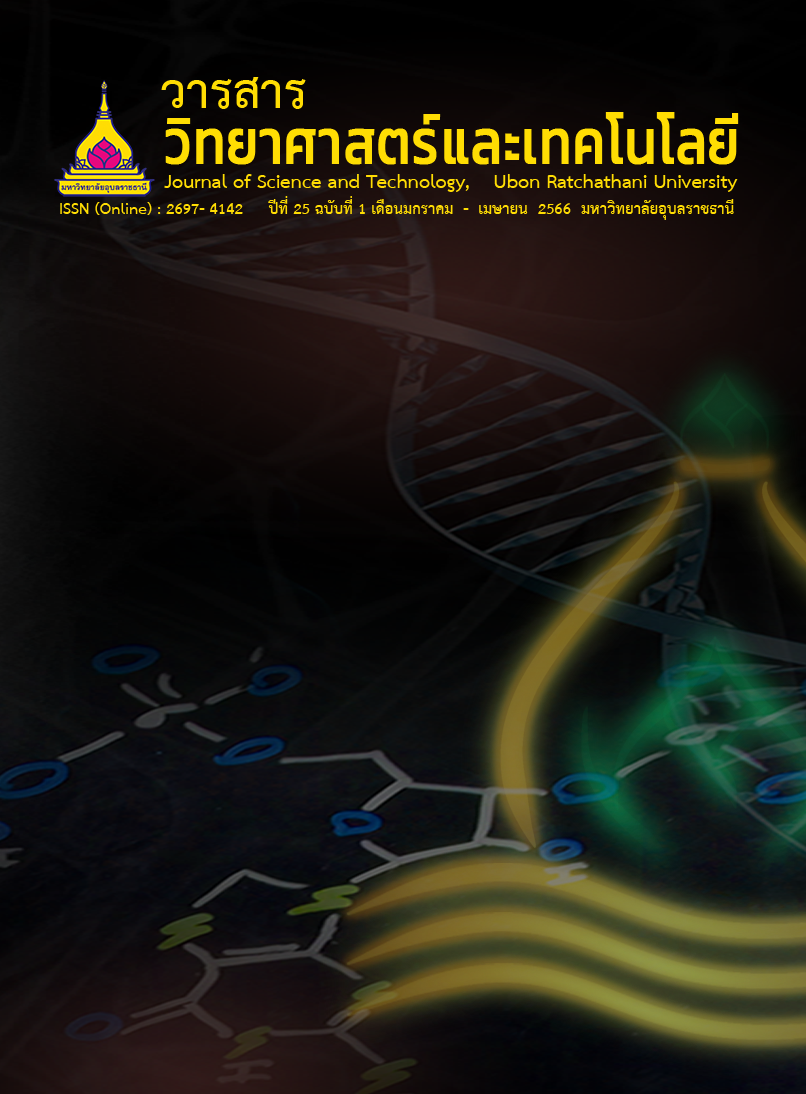ผลของการฝังท่อทองแดงที่ความลึกแตกต่างกันในชั้นยางมะตอยต่อประสิทธิภาพเชิงความร้อน ของเครื่องทำน้ำร้อนพลังงานแสงอาทิตย์แบบยางมะตอย
Main Article Content
บทคัดย่อ
บทความนี้มีวัตถุประสงค์เพื่อศึกษาผลของการฝังท่อทองแดงที่ความลึกแตกต่างกันในชั้นยางมะตอยต่อประสิทธิภาพเชิงความร้อนของเครื่องทำน้ำร้อนพลังงานแสงอาทิตย์แบบยางมะตอย เครื่องทำน้ำร้อนพลังงานแสงอาทิตย์ที่ใช้ในการศึกษานี้ทั้งสองแบบ (Type A และ Type B) มีตัวดูดกลืนรังสีที่ทำจากยางมะตอยผสมสำเร็จขนาดเท่ากับ 0.8 เมตร x 0.8 เมตร ด้านบนปิดด้วยแผ่นกระจก ในชั้นยางมะตอยมีการฝังท่อทองแดง สำหรับเครื่องทำน้ำร้อน Type A เพียง 3 ใน 4 ส่วนของเส้นผ่านศูนย์กลาง (7.5 มิลลิเมตร) ของท่อทองแดงถูกฝังลงไปในชั้นยางมะตอย และสำหรับเครื่องทำน้ำร้อน Type B ท่อทองแดงถูกฝังลึกจากผิวของชั้นยางมะตอย 25 มิลลิเมตร จากการศึกษาพบว่าอุณหภูมิสูงสุดของยางมะตอยผสมสำเร็จ และอุณหภูมิน้ำร้อน คือ 69 องศาเซลเซียส และ 53.70 องศาเซลเซียส ตามลำดับ สำหรับเครื่องทำน้ำร้อน Type A และ 70.5 องศาเซลเซียส และ 50.4 องศาเซลเซียส ตามลำดับ สำหรับเครื่องทำน้ำร้อน Type B นอกจากนี้ยังพบว่าเครื่องทำน้ำร้อน Type A มีค่าประสิทธิภาพเซิงความร้อนสูงสุดเท่ากับ 80% เฉลี่ยรายวันอยู่ที่ 57% ส่วนเครื่องทำน้ำร้อน Type B ค่าประสิทธิภาพเซิงความร้อนสูงสุดเท่ากับ 69% เฉลี่ยรายวันอยู่ที่ 44% การศึกษานี้แสดงให้เห็นว่าการฝังท่อทองแดงลงไปยังตัวดูดกลืนรังสีอาทิตย์ที่ความลึกแตกต่างกันมีผลต่อประสิทธิภาพเชิงความร้อนของเครื่องทำน้ำร้อนพลังงานแสงอาทิตย์
Article Details

อนุญาตภายใต้เงื่อนไข Creative Commons Attribution-NonCommercial-NoDerivatives 4.0 International License.
บทความที่ได้รับการตีพิมพ์เป็นลิขสิทธิ์ของ วารสารวิทยาศาสตร์และเทคโนโลยี มหาวิทยาลัยอุบลราชธานี
ข้อความที่ปรากฏในบทความแต่ละเรื่องในวารสารวิชาการเล่มนี้เป็นความคิดเห็นส่วนตัวของผู้เขียนแต่ละท่านไม่เกี่ยวข้องกับมหาวิทยาลัยอุบลราชธานี และคณาจารย์ท่านอื่นๆในมหาวิทยาลัยฯ แต่อย่างใด ความรับผิดชอบองค์ประกอบทั้งหมดของบทความแต่ละเรื่องเป็นของผู้เขียนแต่ละท่าน หากมีความผิดพลาดใดๆ ผู้เขียนแต่ละท่านจะรับผิดชอบบทความของตนเองแต่ผู้เดียว
เอกสารอ้างอิง
Sarachitti, R. and et al. 2011. Thermal performance analysis and economic evaluation of roofintegrated solar concrete collector. Energy and Buildings. 43(6): 1403-1408.
Ministry of Energy. 2018. Alternative Energy Development Plan 2018-2037 (AEDP 2018-2037). Bangkok: Department of Alternative Energy Development and Efficiency, Ministry of Energy. (in Thai)
Duffie, J.A. and Beckman, W.A. 1980. Solar Engineering of Thermal Process. New York: Wiley Interscience Publication.
Padakan, R. and Radagan, S. 2010. A study of the factors that affect the efficiency of hot water systems. Kasetsart Engineering Journal. 70: 96-109. (in Thai)
Riamsuwan, S. 2012. Comparison of Hot Water Systems between Using Heat Pump and Using Flat Plate Solar Collector for Residential Building. M.Sc. Thesis, Chulalongkorn University. (in Thai)
Duangjaiboon, K. 2018. Feasibility Study on Hybrid Solar Hot Water for hotel building. Academic Journal Uttaradit University. 13(1): 65-78. (in Thai)
American Society of Heating, Refrigerating and Air-Conditioning Engineers. 1977. Methods of Testing Determine the Thermal Performance of Solar Collectors. ASHRAE Standard 93-77. New York: American Society of Heating, Refrigeration, and Air Conditioning Engineers.
Poomsawat, S. and Poomsawat, W. 2019. A study of the efficiency of a solar water heater. Srinakharinwirot University Engineering Journal. 1: 66-77 (in Thai)
Tchuen, G. and Kohole. W.Y. 2018. A numerical investigation of three different thermosyphon solar water heating systems. International Journal of Ambient Energy. 39(6): 637-648.
Yassen, T.A., Mokhlif, N.D. and Eleiwi, M.A. 2019. Performance investigation of an integrated solar water heater with corrugated absorber surface for domestic use. Renewable Energy. 138: 266-273.
Bhowmik, H. and Amin, R. 2017. Efficiency improvement of flat plate solar collector using reflector. Energy Reports. 3: 119-123.
Chantawong, P. and Thantong, P. 2013. Study of a solar collector wall for domestic hot water and natural ventilation of a model house in a tropical climate. Journal of Science and Technology, Ubon Ratchathani University. 15(3): 21-29. (in Thai)
Pukdum, J., Phengpom, T. and Sudasna, K. 2019. Thermal performance of mixed asphalt solar water heater. International Journal of Renewable Energy Research. 9(2): 712-720.
Pukdum J., Sudasna, K. and Phengpom, T. 2020. Experimental study on heat gain reduction and economic evaluation of mixed asphalt solar water heater. Journal of Engineering and Applied Science. 15(1): 327-334.
Puangsombut, W. Nonthiworawong, D. and Pukdum, J. 2020. Thermal performance of integrated collector storage solar water heater with mixed asphalt absorber plate. The Journal of Industrial Technology: Suan Sunandha Rajabhat University. 8(2): 48-57.


